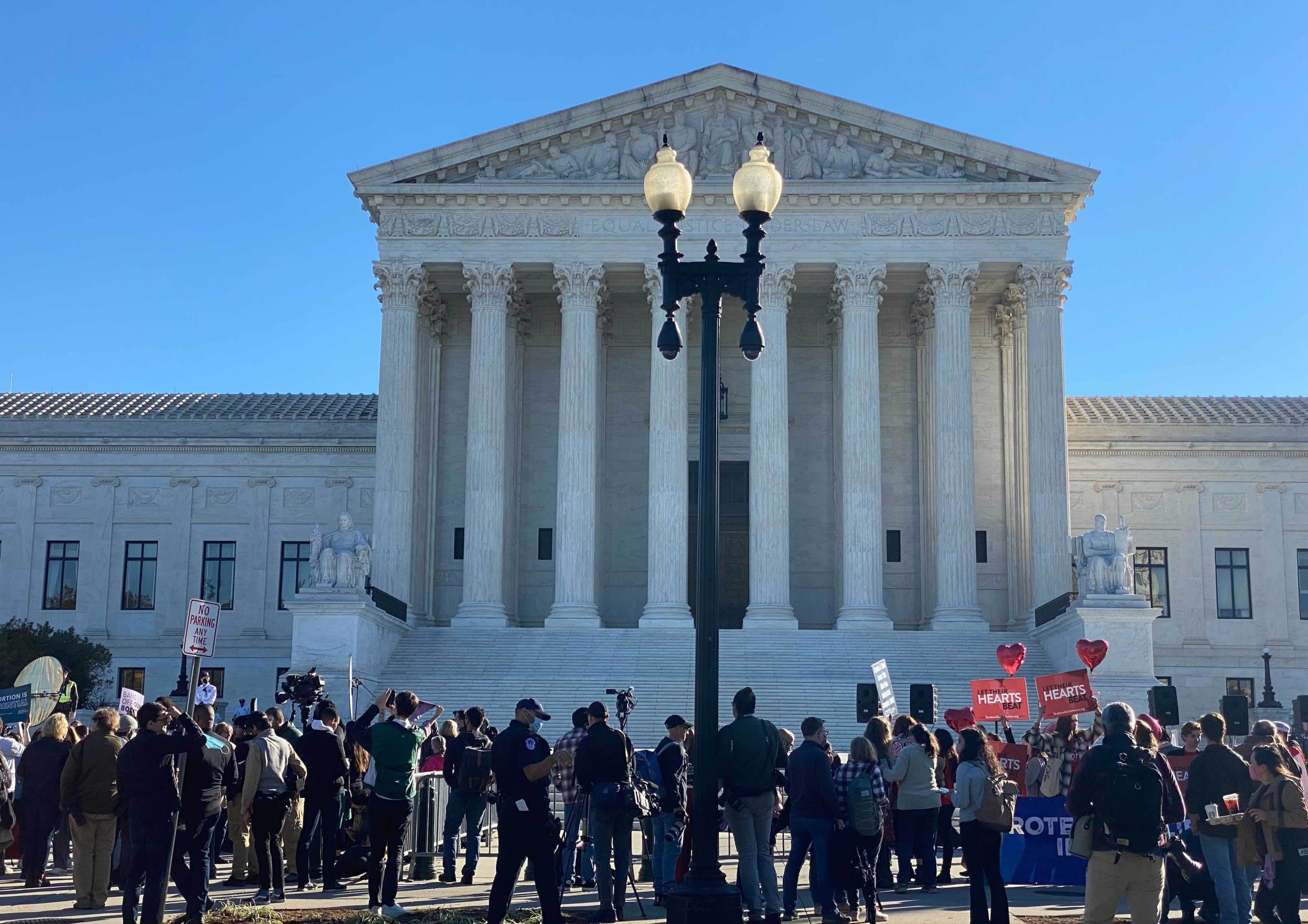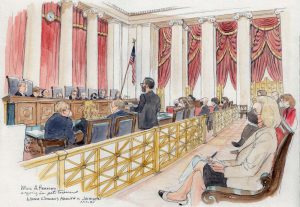Court seems inclined to let abortion providers pursue their challenge to Texas law


This article was updated on Nov. 1 at 5:45 p.m.
The Supreme Court heard oral argument on Monday in two challenges to S.B. 8, the Texas law that bans almost all abortions in the state. After nearly three hours of argument by four different lawyers, the justices appeared likely to allow the case brought by a group of Texas abortion providers to go forward, even if they did not necessarily appear to agree on the rationale for that lawsuit. The justices were more skeptical about the lawsuit filed by the Biden administration, and they did not give any hint as to whether the law will continue to remain in effect.
S.B. 8 prohibits doctors from performing abortions starting around the sixth week of pregnancy. That is a clear conflict with the Supreme Court’s landmark decisions in Roe v. Wade and Planned Parenthood v. Casey, which establish a constitutional right to an abortion up to the point at which the fetus becomes viable, which normally occurs around the 24th week of pregnancy. But Monday’s argument focused primarily on the law’s unusual enforcement mechanism, which distinguishes it from similar abortion bans that have been enacted by other states (and that have been consistently struck down by federal courts). S.B. 8 delegates the sole power to enforce the law to private individuals, rather than state officials. In particular, the law allows anyone, including people who do not live in Texas, to bring a lawsuit in state court against anyone who performs an abortion or helps to make one possible. A plaintiff in a successful lawsuit can receive at least $10,000 in damages, along with costs and attorney’s fees.
By taking away any role for the state in enforcing the law, S.B. 8’s drafters hoped to make it harder for opponents of the law to challenge its constitutionality in court, especially before the law went into effect on Sept. 1. They also hoped that the potential expansive liability and significant damages created by the law would deter abortion providers from performing any abortions, including those that would occur before the sixth week of pregnancy. Evidence from the past two months suggests the law is having its desired effect: Clinics have reported turning away many patients seeking abortions, and the number of abortions performed in the state has plummeted.
The two cases before the Supreme Court on Monday are two different efforts to challenge the law. One case, Whole Woman’s Health v. Jackson, began in July as an effort by abortion providers to block the law before it was scheduled to go into effect. The Department of Justice filed the second case, United States v. Texas, in early September after the court declined an emergency request from the abortion providers to put S.B. 8 on hold.
The providers’ challenge
A majority of the justices appeared skeptical that, despite Texas’ arguments to the contrary, no one can bring a lawsuit to challenge S.B. 8 before it is enforced. Justice Elena Kagan seemed to summarize the problem before the court, as well as the sentiment of several of her colleagues, when she observed that the “entire point of” S.B. 8 is to “find the chink in the armor” of Ex parte Young, a 1908 Supreme Court case allowing lawsuits in federal courts against state officials to bar them from enforcing unconstitutional laws, but prohibiting injunctions against state courts. She dismissed the idea that the court’s hands are tied merely because “some geniuses came up with a way to evade the commands of that decision, as well as … the broader principle that states are not to nullify federal constitutional rights.” The court, she suggested, should not simply resign itself to the idea that “we’ve never seen this before, so we can’t do anything about it.”
Justice Brett Kavanaugh echoed Kagan’s point a few minutes later. He told Stone that Ex parte Young “sets out this principle that you can get pre-enforcement review in federal court against state enforcement of laws that are assertedly unconstitutional” – normally, by suing a state official. This case, he explained, involved a “loophole that’s been exploited here, which is the private suits … enforced by state court clerks or judges.” So although the text of Ex parte Young is “strong for you,” he acknowledged to Stone, the rationale of Ex parte Young “would suggest extending the principle here” to allow the providers’ suit to go forward.The justices were mostly unmollified by the argument, made on Monday by Texas Solicitor General Judd Stone, that although pre-enforcement judicial review may not be available, the providers can still challenge S.B. 8 in the state courts if they are sued for violating the law, and they can eventually seek review of those decisions in the Supreme Court. Several justices expressed concern that because the penalties that flow from violations of the statute are both significant and broadly applicable, it will “chill” conduct: No one will be willing to challenge the law through that path, reducing the likelihood of federal court review.
Chief Justice John Roberts observed that, if Texas is correct, the only way an abortion provider can obtain federal court review of S.B. 8’s constitutionality is to violate the law. He outlined a hypothetical in which the penalty for violating the law was $1 million, instead of $10,000. In such a scenario, he posited, “no one is going to risk violating the statute because they’ll be subject to suit for a million dollars,” and so no one is likely to go to federal court at all.
Kavanaugh also asked Stone about S.B. 8’s retroactivity provision. If the law were to be blocked and a clinic legally performed abortions, Kavanaugh queried, would S.B. 8 allow lawsuits based on those abortions if the law later goes back into effect? When Stone responded that it would, Kavanaugh suggested that the retroactivity provision would also have a chilling effect, because of the “prospect of future changes” and “millions and millions of dollars” in potential liability.
And Justice Amy Coney Barrett emphasized that even pre-enforcement litigation in the state courts would simply not be as useful to the providers as litigation in federal courts. You can’t get, she observed, the same kind of global relief in state courts that a pre-enforcement challenge in federal courts would give you “from the prospect that the statute would be enforced against you.”
Justice Neil Gorsuch was more sympathetic, however, to the idea that the providers could obtain judicial review later. He stressed that other laws – involving, for example, gun rights and “rules during the pandemic about the exercise of religion” – “can only be challenged after the fact,” and he did not see any reason to treat S.B. 8 differently.
But other members of the court’s conservative wing openly worried about the prospect that S.B. 8’s enforcement scheme could be used to negate other constitutional rights. Kavanaugh cited a “friend of the court” brief by the Firearms Policy Coalition, a gun-rights advocacy group, arguing that the scheme could, as Kavanaugh put it, “easily be replicated in other states” to target gun rights, free speech rights, or religious rights.
Although six and perhaps even seven justices seemed to agree that the providers’ lawsuit should be allowed to go forward, it wasn’t entirely clear whom the justices regarded as the proper defendant in the case. Marc Hearron, who argued on behalf of the providers, told the justices that the county clerks who would docket the lawsuits against the providers would be the “most straightforward” defendants, because they are not covered by the court’s ruling in Ex parte Young. The providers are seeking a federal court order that would bar the clerks from processing any S.B. 8 lawsuits.

Justices Sonia Sotomayor and Stephen Breyer suggested that the Texas attorney general, Ken Paxton (who sat at counsel table in the courtroom on Monday with Stone), might be an appropriate defendant. If he were properly sued, Sotomayor continued, an injunction against him would also extend to any plaintiffs who filed lawsuits as “private attorneys general.”
And Kavanaugh wondered aloud whether state judges might in fact be fair game after all. The court’s ruling in Ex parte Young hinged on enforcement, he noted, and the court’s later decisions indicated that “when state courts entertain private civil suits, they enforce state law.” One of those decisions, Shelley v. Kraemer, Kavanaugh observed, used the word “enforcement” “27 times, give or take a couple, to describe what state courts do when they adjudicate private civil suits.”
Hearron assented. He pointed out that Judge Austin Jackson, one of the defendants in the providers’ case, has described himself as the “enforcer of the laws in east Texas.”
The federal government’s challenge
Expressing concern that the Biden administration was seeking broad power to bring lawsuits against states, the justices appeared more reluctant to allow the Biden administration’s case to go forward. They pressed Elizabeth Prelogar, who was confirmed last week as the Biden administration’s solicitor general, for examples of similar cases that the federal government had filed against states to protect constitutional rights.
Prelogar countered that she was not aware of examples because the Texas law is so unprecedented. The Biden administration is not asserting a right to sue Texas in federal court merely because the state enacted an unconstitutional law, she explained, but because the state set up an enforcement scheme to thwart judicial review of the unconstitutional law.
Roberts pushed back. He told Prelogar that although she portrayed the case as “very narrow,” “rare,” and “particularly problematic,” the authority you assert to respond to it is broad as can be.” What, Roberts asked, “is the limiting principle?”
But Justice Samuel Alito also resisted any efforts by Prelogar to advance a rule that he regarded as too narrow. If, in the future, the United States can only file a lawsuit against a state when all of the characteristics of S.B. 8 to which the Biden administration objects are present, Alito suggested, “is this what you’re really seeking, a rule for one case?”
Gorsuch also was dubious about the Biden administration’s effort to single out S.B. 8 as worthy of a lawsuit against a state. “We don’t get to pick and choose among our rights,” he admonished Prelogar. “We’re supposed to enforce them equally.” Why, he asked, is S.B. 8 different from other laws with a chilling effect?
Even the discussion in the Biden administration’s case, however, eventually turned back to the providers’ case – so much so that Prelogar began her rebuttal by discussing how a ruling in favor of the providers might affect the government’s case. Prelogar concluded by reiterating what she described as the “startling implications” of the state’s argument. If no one can bring a prospective lawsuit to block a law like S.B. 8, she stressed, then no constitutional right is safe, and none of the Supreme Court’s decisions are safe. “Our constitutional guarantees,” she told the justices, “cannot be that fragile.”
The majority seemed poised to agree with her, at least with regard to the S.B. 8 enforcement scheme. The justices will hear oral argument on Dec. 1 in a challenge to a Mississippi law that bans almost all abortions after the 15th week of pregnancy.
This article was originally published at Howe on the Court.
Posted in Merits Cases
Cases: Whole Woman’s Health v. Jackson, United States v. Texas
